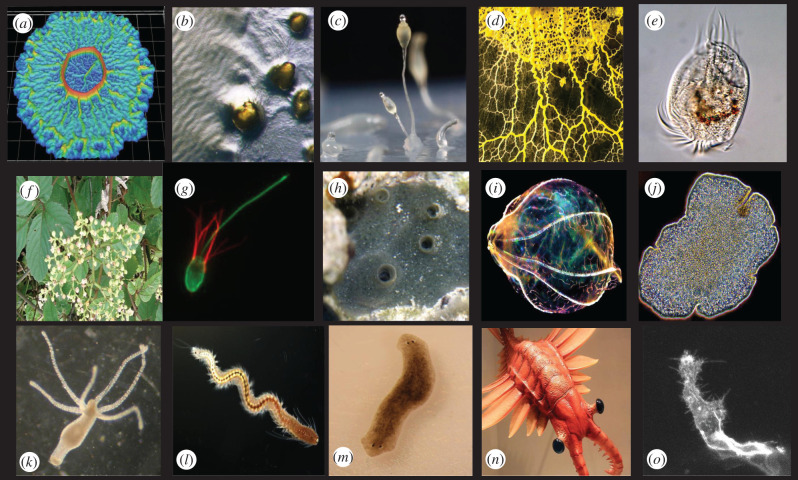Figure 1.
Organisms represented in basal cognition theme issues. Note: Phyla discussed primarily in the second issue have citations. Those discussed primarily in this issue do not. (a) A digital scanned model of a Bacillus subtilis biofilm suggests how the bacterial community develops and changes structure in three dimensions. (Image: Scott Chimileski and Roberto Kolter. https://www.wired.com/story/seeing-the-beautiful-intelligence-of-microbes/.) (b) Myxococcus xanthus has a complex multicellular lifestyle that includes ‘rippling’ behaviour in the presence of prey. (Image: Zalman Vaksman and Heidi Kaplan, University of Texas Medical School, Houston, USA. https://doi.org/10.1371/journal.pcbi.1002715) (c) The social amoeba Dictyostelium discoideum is a unicellular model for studying the evolution of multicellularity. (Image: Usman Bashir, Queller/Strassman laboratory. CC BY-SA. https://commons.wikimedia.org/wiki/File:Dictyostelium_discoideum_02.jpg). (d) The acellular slime mould Physarum polycephalum, by contrast, is a single giant, expanding cell that coordinates behaviour via an oscillating, vascular plasma-transport network. (Image: David Villa SCIENCEIMAGE CBI CNRS.) (e) Predatory ciliate Euplotes exhibits behavioural innovations enabled by the origin of the excitable eukaryotic cell. (Image: Hannah Laeverenz Schlogelhofer and Kirsty Wan, EvoMotion Lab, Living Systems Institute, Exeter, UK.) (f) Tendrils of the plant Cayratia japonica have been found to display self-recognition [50]. (Image: KENPEI, own photo. CC BY-SA 3.0. https://commons.wikimedia.org/w/index.php?curid=2461105). (g) Comparative genomic analysis of the colonial choanoflagellate Salpingoeca rosetta reveals that animals' closest unicellular relative possesses almost as much of the molecular infrastructure for producing neurosecretory vesicles as (h) the sponge Amphimedon queenslandica (Porifera), a closer multicellular relative [33]. (Image of S. rosetta: Burkhardt Group, Sars International Centre for Marine Molecular Biology, University of Bergen, Norway. Image of A. queenslandica: M Adamska et al., Centre for Marine Science, University of Queensland, Brisbane, Australia. CC BY 2.5. https://commons.wikimedia.org/w/index.php?curid=9950094) (i) Beroe sp. (with just-swallowed Bolinopsis inside), a comb jelly found off the Florida Keys, is within the early-branching phylum of eumetazoa (Ctenophora) thought to have independently evolved a nervous system [32]. (Image: L.L. Moroz and G. Pauley.) (j) The aneural placozoan Trichoplax adhaerens possesses a surprising number of signalling peptides that resemble those used in nervous systems [32]. (Image: L.L. Moroz, Whitney Laboratory for Marine Bioscience, Florida, USA.) (k) Hydra vulgaris (Cnidaria), the recent go-to model for imaging whole-organism neural activity, provides additional unexpected insights. (Image: Corvana, own work. CC BY-SA 3.0, https://commons.wikimedia.org/w/index.php?curid=6349873.) (l) Platynereis dumerilii, an annelid polychaete worm and model organism for studying the origin and evolution of the nervous system [51] (Image: Martin Gühmann, own work. CC BY-SA 4.0, https://commons.wikimedia.org/w/index.php?curid=61283244). (m) Research with an experimentally produced 2-headed Planarian (Platyhelminthes) suggests bioelectricity plays a key role in organism regeneration [52]. (n) Artist's impression of Lararapax unguispinus, a large marine predator from the Cambrian Era, when Ginsburg and Jablonka [49] propose that ‘unlimited associative learning’ originated. (Image: Yinan Chen. https://commons.wikimedia.org/wiki/File:Gfp-anomalocaris-predator.jpg). (o) A blood vessel sprout grows in the zebrafish (Danio rerio) embryo, where long, thin projections (filopodia) speed up collective cell decisions based on ‘active perception’—sensorimotor feedback as they move [34]. (Image: Cellular Adaptive Behaviour Lab, Francis Crick Institute, London, UK.)

